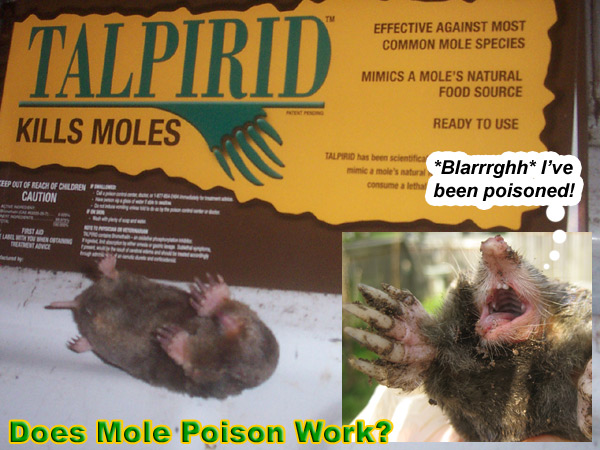- info@wildlife-removal.com
Call us for help in your town
Wildlife Removal Education
Mole Poison
Need mole removal in your hometown? We service over 500 USA locations! Click here to hire us in your town and check prices - updated for year 2020.
Click here for a nationwide list of 100's of professional mole trappers serving all 50 states.
Many mole poisons are marketed and sold. There are "poison peanuts", and fake gummy worms with poison, and poison seeds, and all sorts of poison. And yes, it is lethal poison. The problem is that it will NEVER EVER work
for actually killing moles, because a mole will never eat poison. Moles eat only live earthworms and grubs and a few insects. Mostly, live earthworms. They will not touch anything that's already dead, or something
that isn't meat. Moles don't eat peanuts or seeds, and they don't eat gummy worms. They eat live subterranean earthworms and grubs. They hunt by sound. They'll never eat a mole poison, end of story. Mole poisons
are a waste of time. The only thing that solves a mole problem is lethal trapping and removal.
 Mole Poison - Poison, like any lethal substance, is not something to be taken lightly, even when the subject matter is in relation to pest removal. Poisons are a combination of lethal substances created for the sole purpose of causing death once ingested or touched.
Mole Poison - Poison, like any lethal substance, is not something to be taken lightly, even when the subject matter is in relation to pest removal. Poisons are a combination of lethal substances created for the sole purpose of causing death once ingested or touched.
Most mole removal poisons on the market are based on the science of anti-coagulation. Anti-coagulation doesn’t sound all that horrible when you read about it on the poison label. In fact, anti-coagulation is a relatively innocuous word. The mechanism behind this word is what makes it scary. Blood requires Vitamin K in order to clot, and clotting needs to occur to stop bleeding. Without the ability to clot, an animal or human cannot seal wounds. Anti-coagulation poisons work by inhibiting a rodent’s ability to produce Vitamin K in the gastrointestinal system where it is produced. Anti-coagulant poisons also contain chemicals that damage the blood vessels in every area of the body. Weak blood vessels will hemorrhage, and without Vitamin K, the hemorrhaging will continue until the rodent is dead. This is not a quick process. Death by hemorrhage can take days.
Another form of poison on the market has a base of zinc phosphide. This type of poison reacts to stomach acids, creating a toxic gas that kills the animals from the inside. The benefit to phosphide poisons over anti-coagulants is that pets eating a poisoned rodent will probably not be adversely affected beyond some nausea and vomiting. Calciferols, the third most common form of rodent poison, take up to a week to become fatal. Calciferols deplete Vitamin D and Calcium, and eventually cause death through failure of internal organ function.
Most of the mole poisons on the market are anti-coagulants in a grain-based formula. Poisons are placed near tunnels and maintained for at least a week. Mixed reviews exist on mole poisons, as getting the mole to ingest the agent can be challenging. Moles live underground and rarely need to surface if their earthworm food supply is plentiful. Some tunnels are dug but never used, so it can be difficult determining where to place your selected poison. Mole poisons only affect the moles that eat it, so one mole may die and another may take its place, though this is the case even with trap and release.
Many exterminators stand by the opinion that trapping is the only way to rid a lawn of moles. Trapping these diggers takes a working knowledge of their activities and tunneling habits. Mole traps also differ from mouse traps in style. The anatomy of a mole is not exactly like that of a mouse, so mouse traps will not always work, nor will a mole be enticed to a mouse trap the way a mouse is. Mole traps are difficult to set, and may require the expertise of a professional.
If the brown, unsightly tunnels zigzagging across your lawn are too much for you to stand and professional trappers are few and far between, do your research prior to selecting a mole poison. Poisons should only be used when the need is great and no other options are available. Read the poison label and determine what kind of poison you are handling. Knowledge of the different poisons and the way they affect living tissue can help you make the most humane choice possible. Knowing what mole poison you use can also help you protect your pets and any innocent animals that cross paths with the substance or the mole itself.
Unfortunately, moles are difficult to remove and can do major damage to landscaping. If in doubt, call in a professional exterminator. Professionals can remove animals of all kinds with the most ethical and responsible means available.
For more information, go to may main mole removal page or the How to Get Rid of Moles page.


















